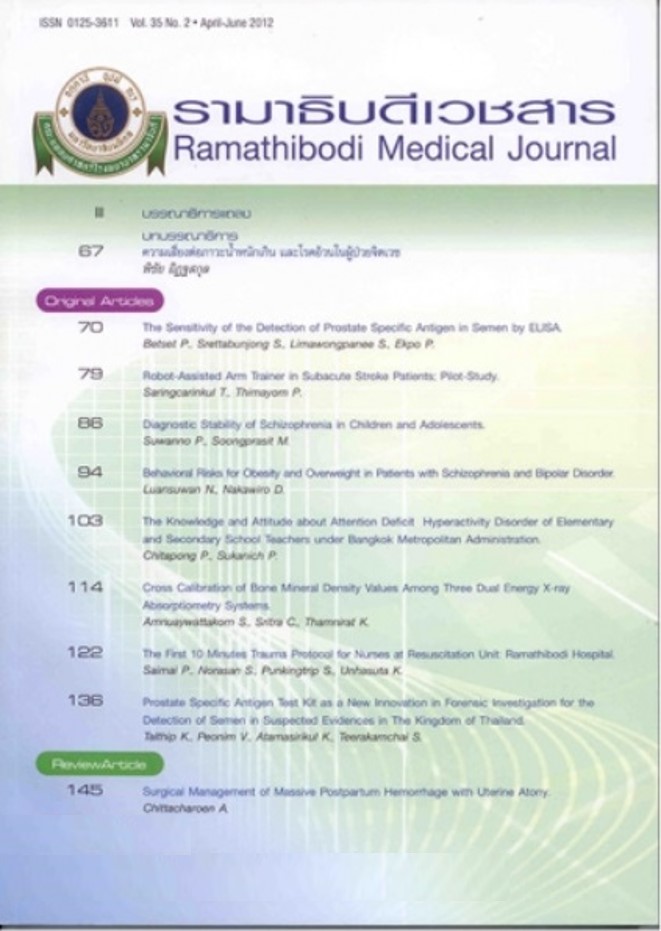Robot-Assisted Arm Trainer in Subacute Stroke Patients; Pilot-Study
Keywords:
Stroke, Subacute, Hemiparesis, Robotics, Upper limbs, Motor function, Activity functionAbstract
Objective: To study whether a robot-assisted arm trainer (AT = Bi-Manu track), utilizing repetitive cycles of passive and active bilateral forearm and wrist movements, will improve motor and functional scores of the upper limb in moderate to severely affected subacute stroke patients.
Designs: Randomized-controlled trial study
Settings: Prasat Neurological Institute
Subjects: Twenty subacute [< 3 month after stroke] hemiplegic stroke patients with severe upper limb paresis; Fugl-Meyer Motor Score of upper extremities [FM UE 27]
Methods: Twenty patients were randomly assigned to either the occupational therapy program [OT] or OT with AT. All patients practiced for 30 min/day, 3-5 days per week, for at least 4 weeks. In addition, AT patients exercised 30 minutes per day with the robot. The primary measurement of progress was the motor score [FM UE 0-66], and the secondary measurements were functional scores [the Manual Function Test, MFT 0-32] and muscle tone [Modifies Ashworth Score, MAS 0-4]
Results: After intervention, FM UE and MFT scores improved over 4 weeks in both OT and OT+AT group, but muscle tone remained unchanged. However, no statistically significant difference was observed on the FM UE, MAS and MFT between both groups.
Discussion and Conclusion: The results from this study indicate that AT provides on additional benefits to conventional occupational therapy. However, alternate studies measuring different variables should be conducted to further assess the impact of AT.
References
Health Information Unit, Strategy and Planning Division. https://bps.moph.go.th/new_bps/.
Schaechter JD. Motor rehabilitation and brain plasticity after hemiparetic stroke. Prog Neurobiol. 2004 ;73(1):61-72. doi:10.1016/j.pneurobio.2004.04.001.
Dimyan MA, Cohen LG. Neuroplasticity in the context of motor rehabilitation after stroke. Nat Rev Neurol. 2011;7(2):76-85. doi:10.1038/nrneurol.2010.200.
Krebs HI, Volpe BT, Aisen ML, Hogan N. Increasing productivity and quality of care: robot-aided neuro-rehabilitation. J Rehabil Res Dev. 2000;37(6):639-52.
Volpe BT, Krebs HI, Hogan N, Edelstein OTR L, Diels C, Aisen M. A novel approach to stroke rehabilitation: robot-aided sensorimotor stimulation. Neurology. 2000;54(10):1938-44. doi:10.1212/wnl.54.10.1938.
Aisen ML, Krebs HI, Hogan N, McDowell F, Volpe BT. The effect of robot-assisted therapy and rehabilitative training on motor recovery following stroke. Arch Neurol. 1997;54(4):443-6. doi:10.1001/archneur.1997.00550160075019.
Lum PS, Burgar CG, Shor PC, Majmundar M, Van der Loos M. Robot-assisted movement training compared with conventional therapy techniques for the rehabilitation of upper-limb motor function after stroke. Arch Phys Med Rehabil. 2002;83(7):952-9. doi:10.1053/apmr.2001.33101.
Hesse S, Schulte-Tigges G, Konrad M, Bardeleben A, Werner C. Robot-assisted arm trainer for the passive and active practice of bilateral forearm and wrist movements in hemiparetic subjects. Arch Phys Med Rehabil. 2003;84(6):915-20. doi:10.1016/S0003-9993(02)04954-7.
Hesse S, Werner C, Pohl M, Rueckriem S, Mehrholz J, Lingnau ML. Computerized arm training improves the motor control of the severely affected arm after stroke: a single-blinded randomized trial in two centers. Stroke. 2005;36(9):1960-6. doi:10.1161/01.STR.0000177865.37334.ce.
Gladstone DJ, Danells CJ, Black SE. The fugl-meyer assessment of motor recovery after stroke: a critical review of its measurement properties. Neurorehabil Neural Repair. 2002;16(3):232-40.
Fugl-Meyer AR, Jääskö L, Leyman I, Olsson S, Steglind S. The post-stroke hemiplegic patient. 1. a method for evaluation of physical performance. Scand J Rehabil Med. 1975;7(1):13-31.
Ansari NN, Naghdi S, Hasson S, Mousakhani A, Nouriyan A, Omidvar Z. Inter-rater reliability of the Modified Modified Ashworth Scale as a clinical tool in measurements of post-stroke elbow flexor spasticity. NeuroRehabilitation. 2009;24(3):225-9. doi:10.3233/NRE-2009-0472.
Michimata A, Kondo T, Suzukamo Y, Chiba M, Izumi S. The manual function test: norms for 20- to 90-year-olds and effects of age, gender, and hand dominance on dexterity. Tohoku J Exp Med. 2008 ;214(3):257-67. doi:10.1620/tjem.214.257.
Miyamoto S, Kondo T, Suzukamo Y, Michimata A, Izumi S. Reliability and validity of the Manual Function Test in patients with stroke. Am J Phys Med Rehabil. 2009;88(3):247-55. doi:10.1097/PHM.0b013e3181951133.
Kwakkel G, Kollen BJ, Krebs HI. Effects of robot-assisted therapy on upper limb recovery after stroke: a systematic review. Neurorehabil Neural Repair. 2008;22(2):111-21. doi:10.1177/1545968307305457













